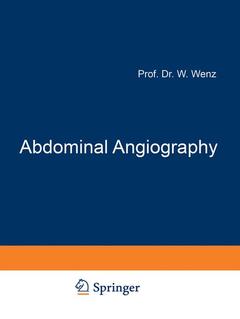Abdominal Angiography, Softcover reprint of the original 1st ed. 1974
Langue : Anglais
Auteur : Wenz Werner

The brilliant yet simple idea of introducing a catheter percutaneously into an artery, without first dissecting it free, using a flexible guide wire, has led to a truly revolutionary breakthrough in abdominal x-ray diag nosis (SELDINGER, 1953). In the meantime, methods and techniques for injecting contrast media into various vessels have become largely standardized; innumerable publications have appeared which deal with every conceivable aspect of angiographic technique and interpretation. This volume is designed to present our experience with abdominal angiography. We deliberately refrained from any systematic discussion of the genitourinary tract, which has been adequately dealt with in the literature, also with respect to angiographic findings. Our interest in the retroperitoneal region is based mainly on its significance in differential diagnosis. In ten years of angiographic activity, our Department had made successful use of a simple technique which appears suitable also for smaller hospitals. We wish to point out its diagnostic potential and, at the same time, to outline its limitations. Our experience embraces 2804 abdominal angiograms, which we have classified according to clinical and morphologic anatomical criteria. Their diagnostic interpretation has been compared with the surgical or histopathological results. This may help others to avoid errors of the type which we discovered in our own work. Angiographic diagnosis requires not only familiarity with normal radiographic anatomy, but also specific knowledge of angiographic patho morphology. We have tried to identify those features which typify the individual findings and to derive therefrom valid generalizations with the aid of simple sketches.
I Introduction and Historical Review.- II Radiologic Anatomy of Abdominal Blood Vessels.- 1 Abdominal Aorta.- 1.1 Symmetric Branches of the Abdominal Aorta.- 1.2 Visceral Branches of the Abdominal Aorta.- 1.2.1 Celiac Trunk.- 1.2.2 Superior Mesenteric Artery.- 1.2.3 Inferior Mesenteric Artery.- 1.3 Nomenclature of Arterial Branches of Celiac Trunk and Mesenteric Arteries.- 2 Inferior Vena Cava.- 3 Portal Vein.- III Angiographic Technique.- 1 Basic Considerations.- 2 Patient Preparation and Contraindications.- 3 Equipment.- 4 Contrast Media and Adverse Reactions.- 5 Aorto-Arteriography.- 5.1 Translumbar Aortography.- 5.2 Indirect or Catheter Aorto-Arteriography.- 5.3 Hettler’s Percutaneous Catheter Method.- 5.4 Retrograde Arterio-Aortography.- 5.5 Intravenous Aortography.- 5.6 Special Techniques.- 6 Portography.- 6.1 Splenoportography.- 6.2 Arterioportography.- 6.3 Omphaloportography.- 7 Cavography.- 8 Pharmacoangiography.- 9 Magnification.- 10 Abdominal Stereoangiography.- 11 Electronic Improvement of Angiograms: Subtraction and Color Subtraction.- 12 Hemodynamic Changes Associated with Angiography.- 13 Complications of Abdominal Angiography.- 13.1 Diagnosis and Therapy of Angiographic Complications.- IV The Abdominal Syndrome and Angiography.- 1 Disorders of Visceral Blood Circulation.- 1.1 History.- 1.2 Acute Occlusion of Visceral Arteries.- 1.2.1 Angiographic Indications and Techniques.- 1.3 Chronic Occlusion of Visceral Arteries.- 1.3.1 Etiology.- 1.3.2 Collateral Circulation.- 1.3.3 Angiographic Indications and Findings.- 2 Gastrointestinal Bleeding.- 2.1 Experimental Groundwork for Angiography.- 2.2 Clinical Observations.- 2.3 Angiographic Technique.- 2.4 Use of Vasoactive Agents for the Treatment of Gastrointestinal Hemorrhages.- 2.5 Visceral Angiography and Hemorrhagic Shock.- 3 Portal Hypertension.- 3.1 Pathophysiology.- 3.2 Prehepatic Block.- 3.3 Intrahepatic Block.- 3.4 Suprahepatic Block.- 3.5 Angiographic Techniques and Indications.- 4 Abdominal Trauma.- 4.1 Angiographic Technique.- 4.2 Angiographic Pathomorphology and Results.- 4.3 Ruptured Diaphragm.- 5 Abdominal Tumors.- 5.1 Angiographic Technique.- 5.2 Angiographic Criteria for Tumors.- 5.2.1 Tumor Vessels.- 5.2.2 Tumor Opacification.- 5.2.3 Arteriovenous Shunts.- 5.2.4 Tumor Radiolucency.- 5.2.5 Expansion and Infiltration.- 5.2.6 Diagnostic Value of Angiographic Tumor Signs.- 6 Abdominal Angiography in Children.- 6.1 Peculiarities of Angiographic Technique in Children.- 6.2 Indications and Results.- V Special Abdominal Angiography.- 1 Abdominal Aorta.- 1.1 Anomalies.- 1.2 Occlusion and Stenosis.- 1.3 Aneurysms and Dissection.- 1.4 Aortocaval Fistula.- 1.5 Inferior Vena Cava.- 2 Liver.- 2.1 Anatomy.- 2.2 Vasculature.- 2.3 Conventional Radiography.- 2.4 Angiographic Techniques.- 2.5 Angiographic Examination of Liver.- 2.6 Arterial Collateral Circulation of the Liver.- 2.7 Angiographic Pathomorphology.- 2.7.1 Primary Malignant Tumors of the Liver.- 2.7.2 Liver Metastases.- 2.7.3 Benign Liver Tumors.- 2.7.4 Parasitic Liver Diseases.- 2.7.5 Subphrenic, Intrahepatic and Subhepatic Abscesses.- 2.7.6 Cirrhosis of the Liver and Portal Hypertension.- 2.7.7 Liver Trauma.- 2.7.8 Aneurysms of the Hepatic Arteries.- 2.7.9 Arterioportal Fistula.- 2.7.10 Obstructive Jaundice.- 2.7.11 Gallbladder.- 3 Spleen.- 3.1 Anatomy and Anomalies.- 3.2 Vasculature.- 3.3 Conventional Radiography.- 3.4 Indications for Splenic Angiography.- 3.5 Angiographic Pathomorphology.- 3.5.1 Tumor in Left Epigastrium.- 3.5.2 Malignant Splenic Tumor.- 3.5.3 Splenic Cyst.- 3.5.4 Splenic Vein Thrombosis.- 3.5.5 Splenic Trauma.- 3.5.6 Accessory Spleen and Displacement of Spleen.- 3.5.7 Aneurysm of the Splenic Artery.- 4 Pancreas.- 4.1 Anatomy.- 4.2 Vasculature.- 4.3 Angiographic Technique.- 4.4 Angiographic Pathomorphology.- 4.4.1 Pancreatic Carcinoma.- 4.4.2 Pancreatic Sarcoma.- 4.4.3 Cystadenoma of the Pancreas.- 4.4.4 Insulinoma and Other Adenomas.- 4.4.5 Zollinger-Ellison Syndrome.- 4.4.6 Acute Pancreatitis.- 4.4.7 Chronic Pancreatitis.- 5 Stomach and Duodenum.- 5.1 Anatomy.- 5.2 Vasculature.- 5.3 Conventional Radiography.- 5.4 Hypotonic Duodenography.- 5.5 Angiographic Technique.- 5.6 Angiographic Pathomorphology.- 5.6.1 Vascular Changes.- 5.6.2 Gastroduodenal Hemorrhage.- 5.6.3 Gastroduodenal Tumors.- 5.6.4 Arteriomesenteric Compression of Duodenum.- 6 Small Intestine and Right Large Intestine.- 6.1 Anatomy.- 6.2 Vasculature.- 6.3 Conventional Radiography.- 6.4 Angiographic Techniques.- 6.5 Angiographic Pathomorphology.- 6.5.1 Pathology and Clinical Aspects of Intestinal Tumors.- 6.5.2 Malignant Tumors.- 6.5.3 Benign Tumors.- 6.5.4 Enteritis and Regional Enteritis.- 6.5.5 Protein-Losing Enteropathy.- 6.5.6 Blood Flow Disturbance.- 6.5.7 Angiodysplasia of the Small and Large Intestine.- 6.5.8 Positional Changes of Small and Large Intestine.- 7 The Left Colon.- 7.1 Anatomy.- 7.2 Vasculature.- 7.3 Conventional Radiography.- 7.4 Angiographic Technique.- 7.5 Indications.- 7.6 Angiographic Pathomorphology.- 7.6.1 Carcinoma of the Colon.- 7.6.2 Colonic Polyposis.- 7.6.3 Ulcerative Colitis.- 7.6.4 Circulatory Disturbances and Ischemic Colitis.- 8 Mesentery and Omentum.- 8.1 Anatomy and Clinical Significance.- 8.2 Vasculature.- 8.3 Angiographic Pathomorphology.- 9 Retroperitoneal Space.- 9.1 Anatomy.- 9.2 Vasculature.- 9.3 Conventional Radiography.- 9.4 Angiographic Technique.- 9.5 Angiographic Pathomorphology.- VI Frequency of Use and Diagnostic Value of Abdominal Angiography.- VII Plates (Figures 1–183).- VIII Bibliography.- IX Subject Index.
Date de parution : 12-1973
Date de parution : 01-2012
Ouvrage de 218 p.
21x27.9 cm
Disponible chez l'éditeur (délai d'approvisionnement : 15 jours).
Prix indicatif 105,49 €
Ajouter au panierThème d’Abdominal Angiography :
Mots-clés :
Angiographie; Baucherkrankung; X-ray; anatomy; angiography; diagnosis; differential diagnosis
© 2024 LAVOISIER S.A.S.



